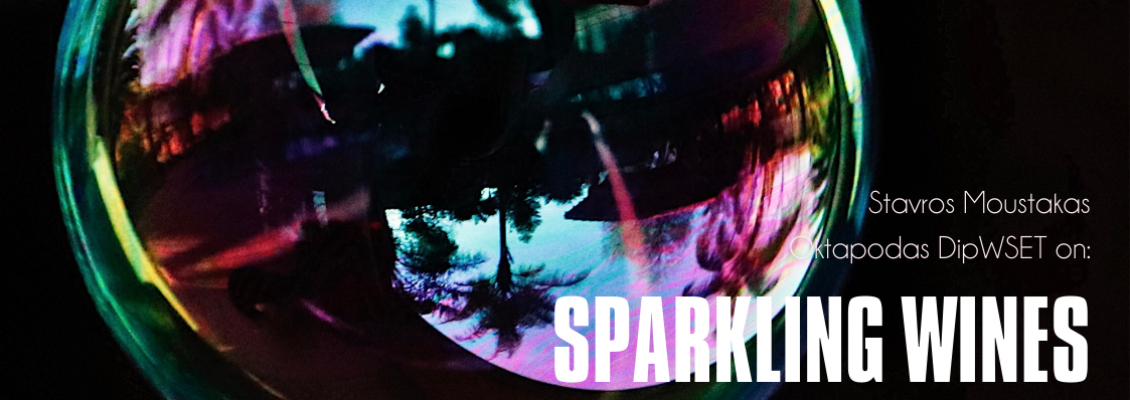Sparkling Wines: Just for celebration or is there more? | Stavros Moustakas Oktapodas DipWSET

Images of joy, celebration and rewarding achievements! Yet, this is the first image that marketing has given us about sparkling wines. Is that it? Or do these wines have the right to boast about their complex and unique characteristics, as well as great culinary qualities?
Let's get to know the sparkling wines together!
.png)
What is a sparkling wine? How is it made?
Okay, it is obvious. We are talking about pressurized content in the bottle, in the presence of carbon dioxide. But how did this idea, which counts hopefully 400 years of life, begin?
Although the initial reports of the first sparkling are in the south of France, in Limoux, we will not spoil your dream and for the sake of convenience we will accept the monk Dom Pérignon as the pioneer of the famous Champagne.
In this region of northern France, absolutely borderline for viticulture, it happened very often that entire harvests were lost because the grapes did not have time to ripen properly before winter arrived. So the wicked monk sat and thought: why not harvest earlier and these early grapes that I will get, which will be fatally sour and without special aromas, I will find a way to make them interesting later.
How? Let's proceed to today. So we take the initial fermentation with the above characteristics which, by the way, also has a low alcohol content (somewhere around 9%), we put it in a bottle and, after pouring in some "sugar" and yeast again, we close it with a soda cap and let it ferment a second time. But, because the bottle is closed, the dioxide produced cannot escape and the wine acquires the coveted bubbles, while at the same time additional alcohol is produced to reach the more familiar 13% volume.
Then, its long stay with the yeasts gives it the complexity it lacks on a fruit level, with notes of baked bread, brioche and butter. This is followed by the final bottling with a special large cork, after a small "adjustment" with minimal sugar, since, as we said, the wines are sour, with very sharp acidity.
All of the above is the method you will read as “traditional” or “classic” or “Champagne method”.
__________ . __________
The original wines of the Champagne appellation of origin are wines of unsurpassed quality, but we will suggest that you also get to know the very competitive efforts of the Greek producers, who for years have been (and are) excelling in this field. Try labels from Karanika, Tselepos, Douloufakis, Kir Yianni, Matamis, Santo, in white and rosé versions, and even elegant Retsinas, such as those by Kechris and Botanic by Nikolou!
Nowadays, however, there is a need to differentiate this style both in terms of aromatic and taste characteristics, as well as on an economic level.
Many producers therefore choose to ferment their wines in special, sealed stainless steel tanks and finish the final product in them, a method ideal for maintaining freshness, fruit and varietal character. The result is wines with fresher aromas, from completely dry and semi-dry (Prosecco type) to sweet (Asti type).
In Greece we are lucky enough to have varieties that are ideal for this job, such as Moschofilero or Malagousia.
__________ . __________
That's good, but do bubbles pair well with food?
Definitely yes! And, in fact, with specific dishes they excel, much more so than still wines. Let's go further: stylistically, sparkling wines -almost always- have high acidity but also their bubbles, both of which are magically made to balance and "wash away" greasy dishes.
Fat fish, a nice rib eye (yes, with Champagne) and, of course, dishes with the pairing killer, the egg, will find a suitable companion in the bubbles. It's no coincidence that Italians prefer their carbonara with a Franciacorta.
On the other hand, simpler sparkling wines make a great companion for salads, raw fish, and pasta dishes.
One last tip: Unless you're still in a totally summery mood by the pool, forget the tall and narrow flute glasses. A good bubbly will show its complex aromatic character only in white wine glasses, while if you have any top dated vintage champagne, even the brief decantation in a carafe is recommended.
Cheers!
Stavros Moustakas Oktapodas DipWSET
_______________________________________________________________
About the Editor:
Having a successful sales career, he entered into the wine world initially as a wine lover, continuously tasting and travelling in the wine regions of Europe, while actively communicating Greek wine through his blog. Certified as WSET Diploma, excelling with two scholarships (best overall performance, and best blind tasting skills in academic years 2016 and 2017). He has been wine consultant at a leading importing company, along with his responsibilities of strategy and communication of Greek wineries.